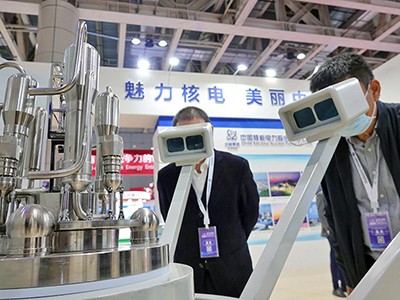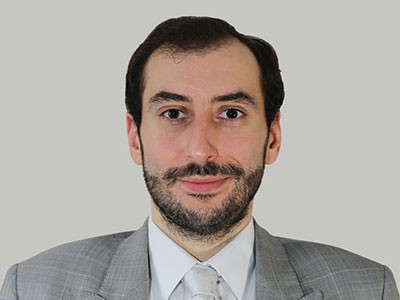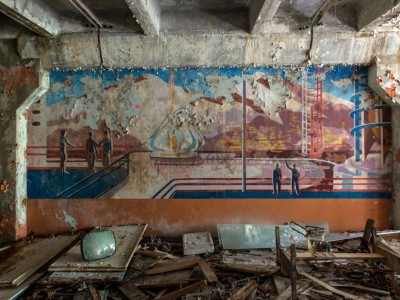[ad_1]
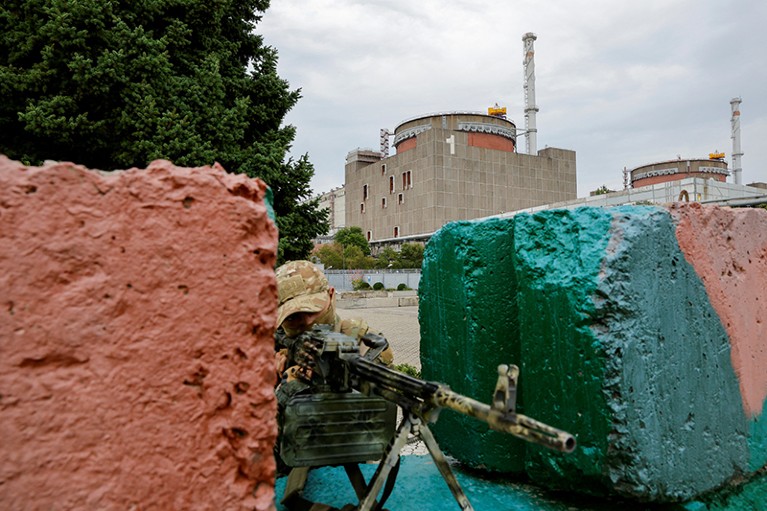
A checkpoint at the Russian-held Zaporizhzhia nuclear plant in Ukraine.Credit: Alexander Ermochenko/Reuters
This year marked the first time in which civilian nuclear-power facilities have come under attack during war. As Russian armed forces pushed into Ukraine in February, troops took control of the Chernobyl nuclear exclusion zone, where hundreds of people still manage the aftermath of the catastrophic 1986 meltdown. Thousands of vehicles stirred up radioactive dust as they moved towards Kyiv. Russian soldiers worked and slept in the deadly ‘red zone’ near the abandoned city of Pripyat.
In March, Russian armoured vehicles and tanks took control of the Zaporizhzhia power station — Europe’s largest nuclear power plant. Conditions rapidly deteriorated. Today, all six reactors are shut down. In August, Russia used artillery located at the plant to shell the city of Nikopol, provoking counterattacks from Ukrainian forces. As witnessed by an International Atomic Energy Agency (IAEA) team sent to report on the situation in September, shelling has disconnected main power lines, knocked out radiation-detection sensors and damaged water pipes, walkways, the fire station and the building housing fresh nuclear fuel and solid radioactive waste1. More power losses in October left backup diesel generators as the only electricity supply to keep fuel rods cool. External power was restored, only to be disrupted again by a landmine explosion. One wrong move, and another Chernobyl could be possible.
Nuclear energy, ten years after Fukushima
The international community must urgently address the inadequacy of nuclear-safety architecture, policy and preparedness.
The powers of the IAEA are limited. It has responded in a rapid and principled way to the crisis in Ukraine, after being unable to prevent the Fukushima disaster following the Tohoku earthquake in Japan in 2011. But the international Convention on Nuclear Safety — one of several treaties that the IAEA serves to reinforce — was never designed to grapple with the nightmare of nuclear-power stations coming under military attack. As a ‘soft-law’ instrument, it allows states to create their own regulatory mechanisms with weak international oversight.
Researchers and policymakers must ask new questions. Are other locations at risk, given the projected global growth in nuclear energy? How do Russia’s actions in Ukraine challenge the world’s commitment to the ‘peaceful uses’ of nuclear energy and to international mechanisms for countering nuclear-weapons proliferation? Can current treaties be adapted, or is a more robust legal architecture and rapid-response capability required? And how can political obstacles be overcome?
Unsafe conditions
Conditions at Zaporizhzhia are “not sustainable and could lead to increased human error with implications on nuclear safety”, the IAEA warned in September1. Ukrainian plant staff are working under duress after Rosatom, the Russian energy company, took control and a Russian holding company was established. Energoatom, Ukraine’s state nuclear-energy company, has reported that the plant’s deputy director and head of human resources have been detained and that others are being pressured to sign contracts with Rosatom. The plant’s director, Igor Murashov, was earlier arrested by Russian forces, interrogated and expelled from Russian-held territory.
The integrity of reactor cores and storage pools is the main concern. If fuel rods are exposed, a core meltdown and uncontrolled release of radiation is likely, as happened at Fukushima, Chernobyl and Three Mile Island in Pennsylvania in 19792. “And so, one mine or one missile or whatever”, warned Ukraine’s energy minister Herman Halushchenko, “could stop the working of the generators and then you have one hour and probably 30 minutes, not more than 2 hours, before the reaction starts.”
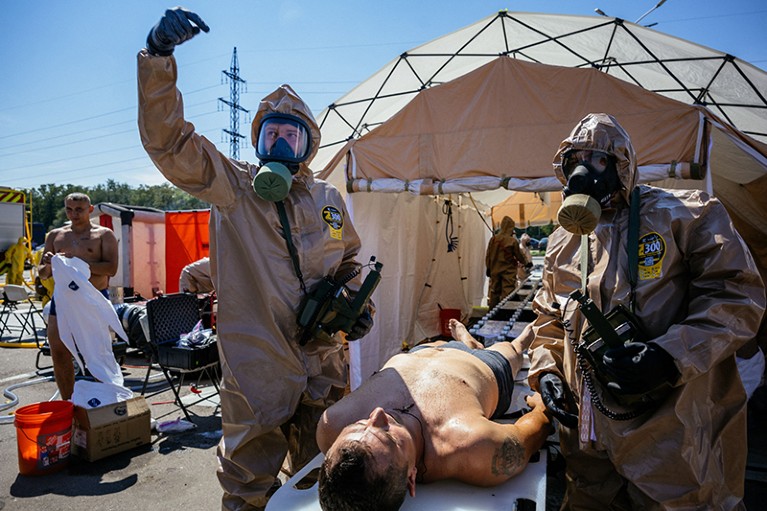
Ukrainian personnel at a nuclear-incident training exercise in Zaporizhzhia in August.Credit: Dimitar Dilkoff/AFP via Getty
Russian control of the plant also delayed the IAEA from conducting its required annual inspection, which is crucial for ensuring safety and verifying the secure disposal of nuclear fuel and preventing its diversion for military uses1.
Nuclear-power plants elsewhere in Ukraine are also under threat. Shelling has been reported at the Khmelnytskyy plant in Netishyn, and cruise missiles have overflown the South Ukraine plant in Yuzhnoukrainsk. And Ukraine’s energy infrastructure across the country is coming under attack, including substations linked to nuclear plants.
Even without considering Russia’s veiled threats to use nuclear weapons in the war, these events put the ability of international organizations to prevent and contain the crisis under unprecedented stress. And, looking ahead, as nuclear energy is deployed around the world, Ukraine might not be the only location with power plants at risk from conflict.
Globally, 57 units to supply 60 gigawatts (GW) of new nuclear power are under construction, mostly outside Europe3. China plans to quadruple nuclear power generation to 180 GW by 2035, adding 150 new reactors to its existing 47, at a cost of US$440 billion. India operates 22 reactors and is constructing 7 new ones; Bangladesh, Belarus, Turkey and the United Arab Emirates are each building their first.
Nuclear power can help the democratic world achieve energy independence
Turkey’s borders with Iraq and Syria have been highly unstable, complicated further by persistent conflict with its Kurdish minority and the extremist Islamist movement Daesh. Relations between India and Pakistan have been more stable since the 1999 ‘Kargil war’, but border fighting regularly breaks out. India–China relations are also tense, but a Ukraine scenario seems unlikely. The most immediately concerning situation would be the deployment of troops from the Chinese mainland to Taiwan, which has three civilian nuclear reactors.
Given the old designs of many nuclear plants and the large amounts of waste in above-ground storage, such concerns will persist for decades as the conflict landscape changes.
Treaty talks
United Nations and IAEA leaders have begun to discuss what needs to be done. Soon after the war in Ukraine began, the IAEA published ‘seven pillars’ of nuclear safety in armed conflict. These stress the need to do the following: secure the physical integrity of plants; maintain fully functional safety and security systems and equipment; ensure plant and safety staff can fulfil their duties without pressure; ensure a constant, secure off-site power supply from the grid; ensure uninterrupted logistical supply chains and transport to and from the site; maintain effective on-site and off-site radiation-monitoring systems, and emergency preparedness and response measures; and maintain reliable communications with the regulator and others1.
These are sound principles, and long overdue. But they are simply guidelines and have no international legal standing.
Addressing the UN Security Council on 6 September, secretary-general António Guterres warned about Zaporizhzhia: “All efforts to re-establish the plant as purely civilian infrastructure are vital.” He endorsed the IAEA call for the immediate demilitarization of the area and the establishment of a nuclear safety and security zone around the plant — an innovative concept. He also highlighted the weakness of the global nuclear governance system, the Treaty on the Non-proliferation of Nuclear Weapons.
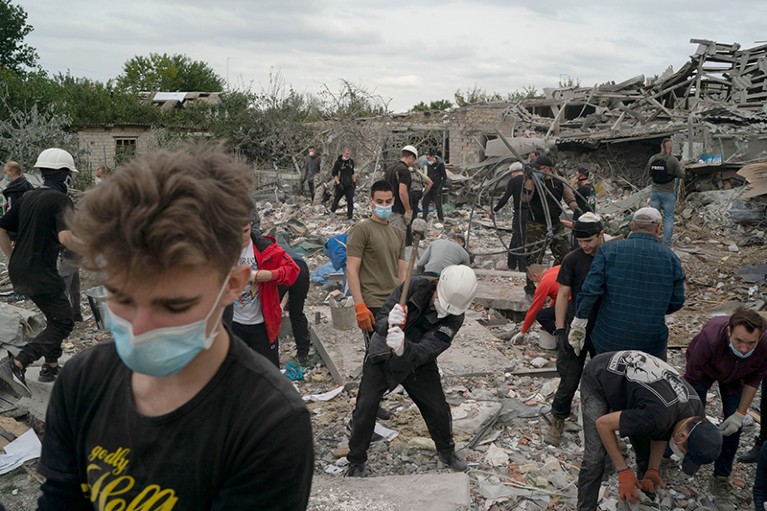
Volunteers clear debris after a Russian attack on a residential area of Zaporizhzhia, Ukraine.Credit: Leo Correa/AP/Shutterstock
The five-yearly review conference of the treaty, in August, was fractured by division and ended in a stand-off. Russia blocked the adoption of a draft outcome document that would have strengthened the treaty by considering, for the first time, the safety and security of nuclear-power plants in armed conflict zones, including Ukraine.
The document is strongly worded. It states that4: “attacks or threats of attack on nuclear facilities devoted to peaceful purposes have dangerous political, economic, human health, and environmental, implications and raise serious concerns regarding the application of international law, which could warrant appropriate action in accordance with the provisions of the Charter of the United Nations”.
The conference’s failure is only one facet of the unprecedented challenge to the global governance of nuclear safety posed by the crisis. International law is gravely inadequate, and the IAEA’s proposed responses are untested.
Attacks on “other military objectives located at or in the vicinity” of nuclear-power stations are prohibited under Article 56 of the Additional Protocol I to the Geneva Conventions. This prohibits military attacks on “works or installations containing dangerous forces, namely dams, dykes and nuclear electrical generating stations … even where these objects are military objectives, if such attack may cause the release of dangerous forces and consequent severe losses among the civilian population”.
Scientists in Ukraine have long fought for scientific freedom
Yet the protocol provides a get-out clause. It permits strikes on “other military objectives located at or in the vicinity of these works or installations only if they are used in regular, significant and direct support of military operations and if such attack is the only feasible way to terminate such support”.
Other key treaties are no help. The Convention on the Physical Protection of Nuclear Material and Nuclear Facilities is aimed at preventing the theft of nuclear material; it explicitly excludes armed conflict. The Convention on Nuclear Safety is a voluntary instrument that is focused on non-military risks. It was found wanting at Fukushima, where Japan’s nuclear safety culture failed to account for known tsunami risks and the plant’s operator, Tokyo Electric Power Company, skirted safety requirements. The convention merely requires countries to report to a ‘peer review’ mechanism, to which the IAEA can provide expert input. When it comes to safety, the IAEA does not hold the robust inspection powers that it has regarding uranium enrichment, for which it can access almost any site at any time.
The IAEA’s call for the demilitarization of the Zaporizhzhia site is consistent with the Geneva Conventions and should be enacted urgently. A ‘nuclear safety and security protection zone’ is a more complex matter.
Demilitarization of the site, subject to a UN Security Council resolution, would be uncontroversial. But how could such a situation be monitored and secured? A small, neutral international peacekeeping force tasked with supporting the IAEA’s mission there is one option. However, if attacks on the plant continue, they might be faced with the need to suppress troop incursions or rocket or artillery strikes on the site. This would require rapid access to air power and entail significant risks.
Given Russia’s veto on the Security Council, a resolution would be impossible to obtain without prior agreement. A resolution should nonetheless be pursued. Negotiations over ceasefires, withdrawals and peacekeeping forces often run in tandem. A well-designed deployment can put moral and strategic pressure on combatants to comply.
Next steps
The most urgent priority is the withdrawal of Russian military personnel and weapons from the Zaporizhzhia plant, and to ensure there are no further attacks on it or its power sources. The security of other Ukrainian plants, including Chernobyl, must also be guaranteed. Following that, a more formal security and protection zone should be established through negotiations between the parties, ideally formalized in a Security Council resolution.
Rosatom’s control of the plant and Russia’s annexation of the Zaporizhzhia region add unwelcome complications. Russia needs to recall the pragmatic spirit of the cold war, when, despite their bitter conflict, the superpowers cooperated to reduce the risks of nuclear war and proliferation in the global security interest. Today is another such time.
Next, the IAEA’s seven pillars need to be put into international law, first through a Security Council resolution and then in a concise and focused new convention. Additional Protocol I should also be amended to remove any right to attack a nuclear-power plant during conflict. The threat to civilian life, ecosystems and economies from a large-scale radiation release is too grave.
How a small nuclear war would transform the entire planet
Scholars, non-governmental organizations, the civilian nuclear industry, and the IAEA also need to devote more resources to research into making nuclear plants safer5.
New reactor, fuel-storage and site designs are needed that can withstand armed and terrorist attacks. A 2006 report from the US National Academies of Sciences, Engineering, and Medicine — commissioned by Congress after the 9/11 Commission discovered that al-Qaeda had considered crashing planes into US nuclear plants — recommended improved fuel-pool designs and prompt transfer of fuel to dry storage after five years6. It did not consider the danger of military attack. Industry resisted the recommendations because of their cost, and similar analysis for nuclear plants outside the United States is sparse.
The report’s recommended changes to fuel-pool designs were minimal, and it admitted that risks were site- and design-specific. An important starting point will be the IAEA’s 2020 Safety Guide SSG-637, which sets out rigorous and challenging new standards for operators. Yet the IAEA does not consider military attack as a specific risk influencing required design parameters8.
Scholarship is also needed on international conflict and security law that can highlight the interaction between nuclear and conflict risks, and gaps in global governance, and can outline viable pathways for reform. Much work on the law of armed conflict — and its supporting philosophy of the ‘just war’ tradition — is overly biased towards state freedoms to wage war and disconnected from non-weapons-related nuclear risks and governance. Zaporizhzhia presents a fresh challenge.
Also needed are wide-ranging and interdisciplinary risk assessments that consider the interactions between existing and future nuclear builds, the risks of conflict, specific site vulnerabilities, and potential loss of life and land from radiation release. Some limited studies seem to have been done but they remain classified; scholars would need to be given access and the information shared internationally (perhaps under IAEA auspices). This is a substantial task that requires significant industry and government investment. It would spur and guide regulators and governments to action.
Russia, Ukraine and much of eastern Europe will be lucky if the Ukraine war ends without disaster at Zaporizhzhia. The world should be ashamed that, nearly 70 years after US President Dwight D. Eisenhower proclaimed the era of ‘atoms for peace’, people are depending on luck. The world’s governments hold the power to prevent disaster. Will they act?
[ad_2]
Source link


